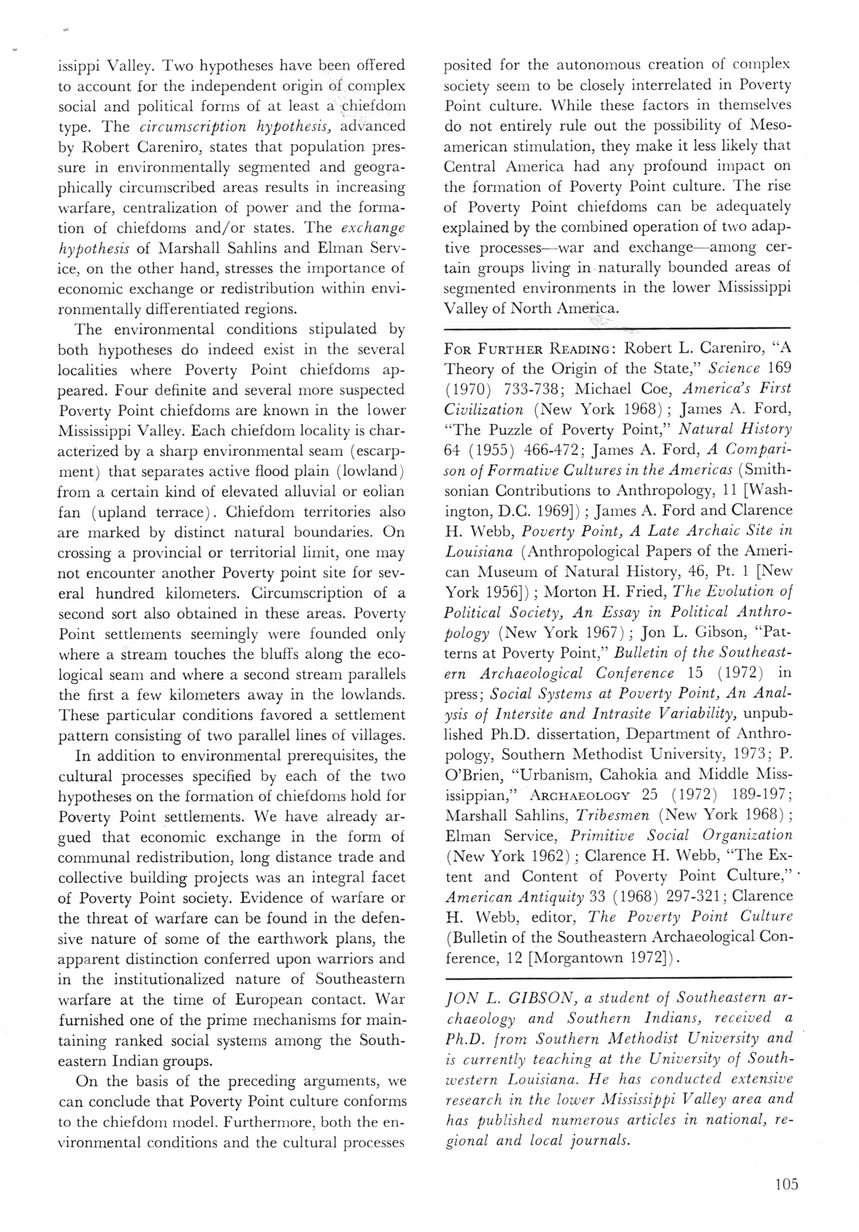This text was obtained via automated optical character recognition.
It has not been edited and may therefore contain several errors.
issippi Valley. Two hypotheses have been offered to account for the independent origin of complex social and political forms of at least a chiefdom type. The circumscription hypothesis, advanced by Robert Careniro, states that population pressure in environmentally segmented and geographically circumscribed areas results in increasing warfare, centralization of power and the formation of chiefdoms and/or states. The exchange hypothesis of Marshall Sahlins and Elman Service, on the other hand, stresses the importance of economic exchange or redistribution within environmentally differentiated regions. The environmental conditions stipulated by both hypotheses do indeed exist in the several localities where Poverty Point chiefdoms appeared. Four definite and several more suspected Poverty Point chiefdoms are known in the lower Mississippi Valley. Each chiefdom locality is characterized by a sharp environmental seam (escarpment) that separates active flood plain (lowland) from a certain kind of elevated alluvial or eolian fan (upland terrace). Chiefdom territories also are marked by distinct natural boundaries. On crossing a provincial or territorial limit, one may not encounter another Poverty point site for several hundred kilometers. Circumscription of a second sort also obtained in these areas. Poverty Point settlements seemingly were founded only where a stream touches the bluffs along the ecological seam and where a second stream parallels the first a few kilometers away in the lowlands. These particular conditions favored a settlement pattern consisting of two parallel lines of villages. In addition to environmental prerequisites, the cultural processes specified by each of the two hypotheses on the formation of chiefdoms hold for Poverty Point settlements. We have already argued that economic exchange in the form of communal redistribution, long distance trade and collective building projects was an integral facet of Poverty Point society. Evidence of warfare or the threat of warfare can be found in the defensive nature of some of the earthwork plans, the apparent distinction conferred upon warriors and in the institutionalized nature of Southeastern warfare at the time of European contact. War furnished one of the prime mechanisms for maintaining ranked social systems among the Southeastern Indian groups. On the basis of the preceding arguments, we can conclude that Poverty Point culture conforms to the chiefdom model. Furthermore, both the environmental conditions and the cultural processes posited for the autonomous creation of complex society seem to be closely interrelated in Poverty Point culture. While these factors in themselves do not entirely rule out the possibility of Meso-american stimulation, they make it less likely that Central America had any profound impact on the formation of Poverty Point culture. The rise of Poverty Point chiefdoms can be adequately explained by the combined operation of two adaptive processes—war and exchange—among certain groups living in naturally bounded areas of segmented environments in the lower Mississippi Valley of North America. For Further Reading: Robert L. Careniro, “A Theory of the Origin of the State,” Science 169 (1970) 733-738; Michael Coe, America’s First Civilization (New York 1968) ; James A. Ford, “The Puzzle of Poverty Point,” Natural History 64 (1955) 466-472; James A. Ford, A Comparison of Formative Cultures in the Americas (Smithsonian Contributions to Anthropology, 11 [Washington, D.C. 1969]); James A. Ford and Clarence H. Webb, Poverty Point, A Late Archaic Site in Louisiana (Anthropological Papers of the American Museum of Natural History, 46, Pt. 1 [New York 1956]); Morton H. Fried, The Evolution of Political Society, An Essay in Political Anthropology (New York 1967); Jon L. Gibson, “Patterns at Poverty Point,” Bulletin of the Southeastern Archaeological Conference 15 (1972) in press; Social Systems at Poverty Point, An Analysis of Intersite and Intrasite Variability, unpublished Ph.D. dissertation, Department of Anthropology, Southern Methodist University, 1973; P. O’Brien, “Urbanism, Cahokia and Middle Miss-issippian,” Archaeology 25 (1972) 189-197; Marshall Sahlins, Tribesmen (New York 1968) ; Elman Service, Primitive Social Organization (New York 1962); Clarence H. W'ebb, “The Extent and Content of Poverty Point Culture,” American Antiquity'i'i (1968) 297-321; Clarence H. Webb, editor, The Poverty Point Culture (Bulletin of the Southeastern Archaeological Conference, 12 [Morgantown 1972]). JON L. GIBSON, a student of Southeastern archaeology and Southern Indians, received a Ph.D. from Southern Methodist University and is currently teaching at the University of Southwestern Louisiana. He has conducted extensive research in the lower Mississippi Valley area and has published numerous articles in national, regional and local journals. 105

Poverty Point (Indian Culture) Poverty Point - John L Gibson (10)